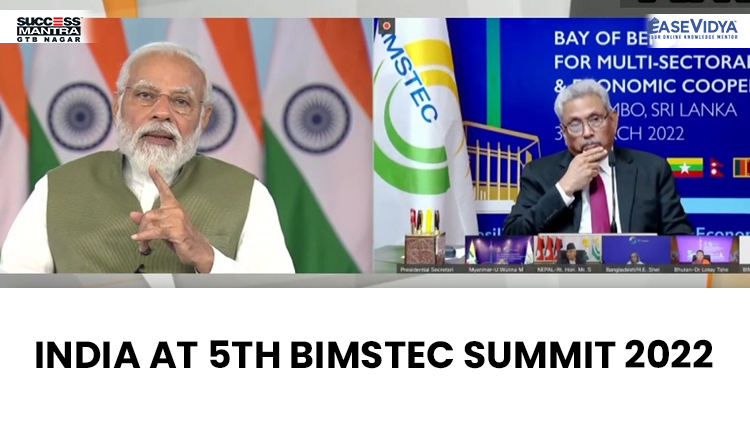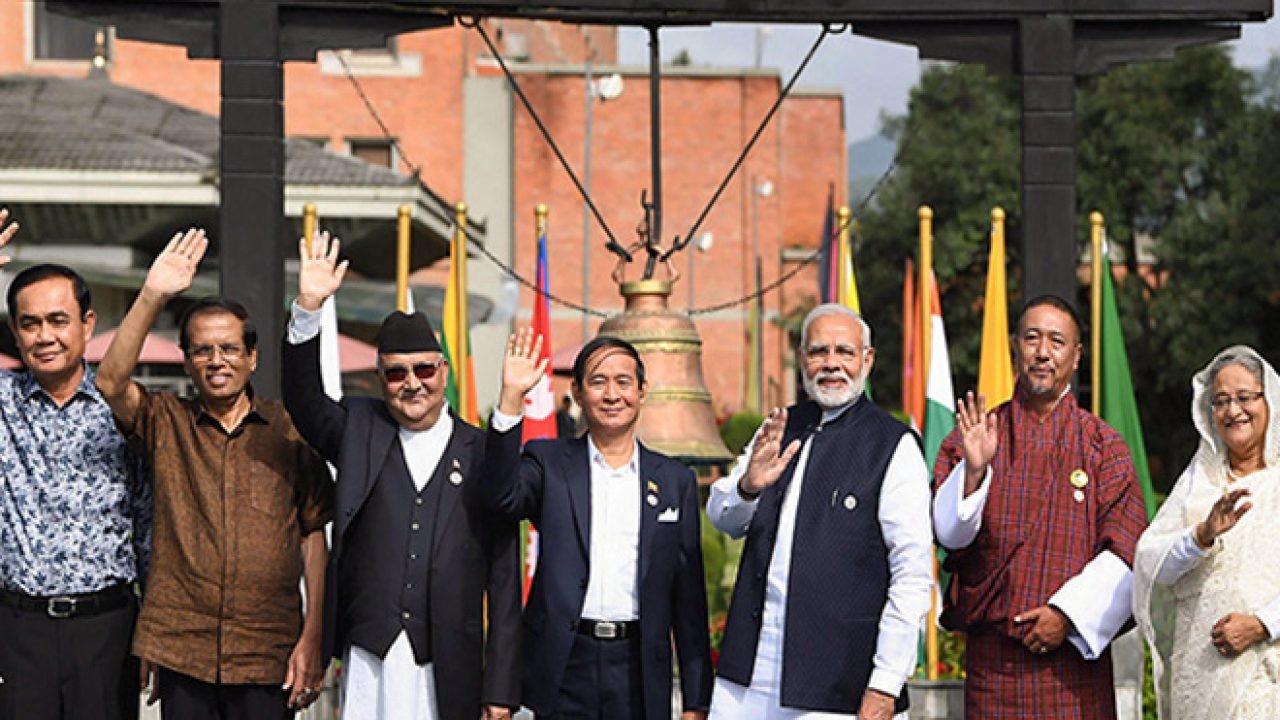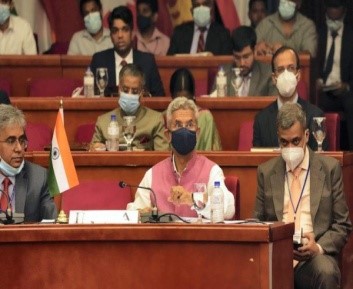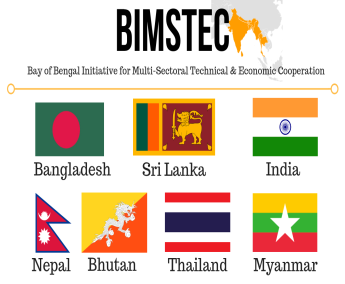
INDIA AT 5TH BIMSTEC SUMMIT 2022
INDIA AT 5TH BIMSTEC SUMMIT 2022
India will provide the BIMSTEC secretariat USD 1 million to increase its operational budget, announced PM Narendra Modi at 5th BIMSTEC Summit on March 30, 2022. He urged that it is important to strengthen the capacity of the BIMSTEC secretariat and suggested the Secretary-General create a roadmap for the same. PM Modi said that the time has come to make the Bay of Bengal the bridge of connectivity, prosperity and security. He called on BIMSTEC nations to dedicate themselves to working with new enthusiasm to achieve the goals they achieved together in 1997. The BIMSTEC Summit 2022 is being hosted in a hybrid mode by Sri Lanka, the current chair of BIMSTEC. Sri Lankan President is chairing the 5th BIMSTEC Summit with the virtual participation of leaders of Bangladesh, Bhutan, India, Nepal and Thailand. The Myanmar Foreign Minister is representing the nation at the summit. The BIMSTEC Senior Officials (SOM) meeting had taken place on March 28, followed by meetings of the BIMSTEC Foreign Ministers on March 29 to prepare for the summit.

BIMSTEC Summit 2022 Theme
The BIMSTEC Summit 2022 theme was “Towards a Resilient Region, Prosperous Economies, Healthy People”. The theme captures the main current priorities of member states.
The main topic of deliberations during the BIMSTEC Summit 2022 included:
- COVID-19 pandemic related challenges.
- Uncertainties within the international system.
- Progress of BIMSTEC as a regional group.
- Establishment of basic institutional structures and mechanisms of the group.
Key Outcome
The main outcome of the BIMSTEC Summit 2022 was the adoption and signing of the BIMSTEC Charter, which formalizes the grouping into an organization with an emblem, flag and formally listed principles to be adhered to. Prime Minister Narendra Modi along with other BIMSTEC leaders also witnessed the signing of 3 BIMSTEC agreements that represent progress being achieved in ongoing cooperation activities.
Current Affairs Notes By Success Mantra Coaching Institute GTB Nagar Delhi CLICK HERE
BIMSTEC AGREEMENTS
The five documents that are to be signed are:
- MoU on mutual cooperation between diplomatic training or academies institutions of BIMSTEC Member States,
- BIMSTEC convention on criminal matters mutual legal assistance,
- Memorandum of Association (MoA) BIMSTEC Technology Transfer Facility establishment in Colombo,
- BIMSTEC Master Plan for Transport Connectivity,
- Reorganization and Rationalization of BIMSTEC’s sub-sectors and sectors.
The Summit also saw considerable progress in BIMSTEC connectivity agenda with adoption of the ‘Master Plan for Transport Connectivity’, which lays out a guidance framework for connectivity related activities in the region in the future.
WHAT ARE THE KEY HIGHLIGHTS OF THE SUMMIT?
BIMSTEC Charter: The signing of the BIMSTEC Charter was the main outcome of this summit. Under this Charter, the members were expected to meet once every two years. With the Charter, the BIMSTEC now has an international personality. It has an emblem, it has a flag. It has a formally listed purpose and principles that it is going to adhere to. In line with the development of the organisation into a formal structure, the leaders of the member-countries have agreed to divide the working of the grouping into seven segments, with India providing leadership to the security pillar.
PILLARS OF BIMSTEC
Master Plan for Transport Connectivity: The summit saw the declaration of the Master Plan for Transport Connectivity that would provide a framework for regional and domestic connectivity.
Other Agreements: Member countries also signed a treaty on mutual legal assistance on criminal matters.
A Memorandum of Association (MoA) on the establishment of BIMSTEC Technology Transfer Facility (TTF) in Colombo, Sri Lanka. India will provide the (BIMSTEC) secretariat USD 1 million US dollars to increase its operational budget.

WHAT IS BIMSTEC?
The Bay of Bengal Initiative for Multi-Sectoral Technical and Economic Cooperation (BIMSTEC) is a regional organisation comprising seven Member States: five deriving from South Asia, including Bangladesh, Bhutan, India, Nepal, Sri Lanka and two from Southeast Asia, including Myanmar and Thailand. This sub-regional organisation came into being on 6 June 1997 through the Bangkok Declaration. With 21.7% of the world’s population and a combined Gross Domestic Product (GDP) of USD 3.8 trillion, BIMSTEC has emerged as an influential engine of economic growth. The BIMSTEC Secretariat is in Dhaka.

Institutional Mechanisms:
- BIMSTEC Summit
- Ministerial Meeting
- Senior Officials’ Meeting
- BIMSTEC Working Group
- Business Forum & Economic Forum
IS BIMSTEC AN ALTERNATE OF SAARC?
The PM of India had invited South Asian Association for Regional Cooperation (SAARC) countries for his swearing in ceremony in 2014, including Pakistan on the lines of his Neighbourhood first policy.
The Prime Minister had also participated in the 18th SAARC summit at Kathmandu in November 2014. However, post Uri attack (on an Indian military base) in October 2016, India gave a renewed push for the BIMSTEC that had existed for almost two decades but been largely ignored. Alongside the BRICS summit in Goa, PM hosted an outreach summit with BIMSTEC leaders. BIMSTEC countries had supported India’s call for a boycott of the SAARC summit scheduled in Islamabad in November 2016. As a result, the SAARC summit was postponed for an indefinite period. Thus, with work on several key initiatives under SAARC stymied because of the breakdown of the relationship with Pakistan, India began focusing on other regional groupings such as BIMSTEC and Indian Ocean Rim Association (IORA). The South Asian Association for Regional Cooperation (SAARC) was established with the signing of the SAARC Charter in Dhaka on 8 December 1985. The idea of regional cooperation in South Asia was first raised in November 1980. After consultations, the foreign secretaries of the seven founding countries—Bangladesh, Bhutan, India, Maldives, Nepal, Pakistan, and Sri Lanka—met for the first time in Colombo in April 1981. Afghanistan became the newest member of SAARC at the 13th annual summit in 2005. The Headquarters and Secretariat of the Association are at Kathmandu, Nepal.
PRINCIPLES OF SAARC
Cooperation within the framework of the SAARC shall be based on:
Respect for the principles of sovereign equality, territorial integrity, political independence, non-interference in the internal affairs of other States and mutual benefit. Such cooperation shall not be a substitute for bilateral and multilateral cooperation but shall complement them.
Such cooperation shall not be inconsistent with bilateral and multilateral obligations.
Members of SAARC
SAARC comprises of eight member States:
- Afghanistan
- Bangladesh
- Bhutan
- India
- Maldives
- Nepal
- Pakistan
- Sri Lanka
There are currently nine Observers to SAARC, namely: (i) Australia; (ii) China; (iii) the European Union; (iv) Iran; (v) Japan; (vi) the Republic of Korea; (vii) Mauritius; (viii) Myanmar; and (ix) the United States of America.
PRAVAHINI Current Affairs Notes By Success Mantra Coaching Institute GTB Nagar Delhi CLICK HERE
TEST YOURSELF
Q.1 India will provide the BIMSTEC secretariat USD 1 million to increase its operational budget, announced PM Narendra Modi at 5th BIMSTEC Summit which was held at?
- Colombo, Sri Lanka: ANSWER
- Kathmandu, Nepal
- Thimphu, Bhutan
- None of the following
Q.2 Consider the given options & state which of the following is correct regarding the theme of the 5th BIMSTEC summit 2022?
- Realizing Opportunities of the 21st Century For All
- People, Planet, Prosperity.
- Towards a Resilient Region, Prosperous Economies, Healthy People: ANSWER
- None of the above
Q.3 In the 5th BIMSTEC summit 2022, many of the important agreements & MoUs have been signed between nations, which of the following is not one of them?
- MoU on mutual cooperation between diplomatic training or academies institutions of BIMSTEC Member States.
- BIMSTEC convention on criminal matters mutual legal assistance.
- BIMSTEC Master Plan for Transport Connectivity.
- I & III is incorrect
- Only II is incorrect
- All of the above-mentioned is incorrect
- None of the following: ANSWER
Q.4 Which of the following given statements is included in the main aims & objectives of the Multilateral organization 'BIMSTEC'?
- Creating an enabling environment for the rapid economic development of the sub-region.
- Restricting or limiting the dominance of China in the Indo-Pacific region: ANSWER
- Promoting active collaboration and mutual assistance in the areas of common interests of the member countries
- Accelerating support for each other in the fields of education, science, and technology, etc.
Q.5 The Kaladan Multimodal Project is an initiative which will link which of the following two nations of BIMSTEC?
- India & Bangladesh
- Myanmar & Bangladesh
- India & Myanmar: ANSWER
- None of the above












0 Comment